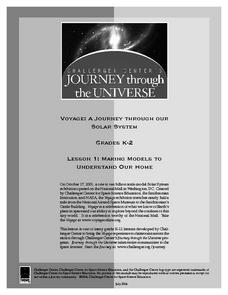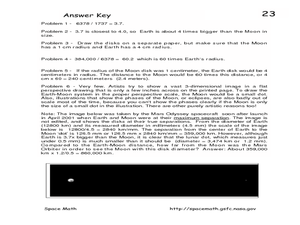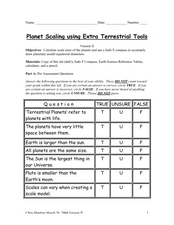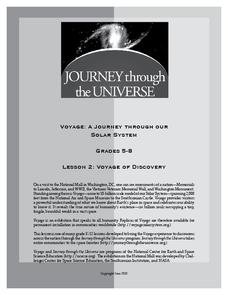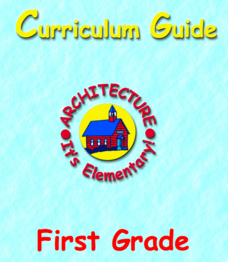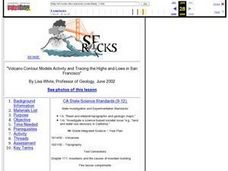Curated OER
Scale/Ratio
Investigate the use of ratios in scale drawings. Learners scale objects up or down using ratios then find the actual size of something using ratios. They apply their knowledge of ratios as they make their own telescopes in science...
Curated OER
3-D Model of Lake Benthos
Young scholars create 3-D models of Lake Benthos. In this scale drawing lesson, students create a 3-D model of Lake Benthos. Young scholars work in groups to create the models. Students use the models to to encourage people to conserve...
Curated OER
Making Models To Understand Our Home
Students investigate the concept of a model and how it is used to represent something that is real. They recognize how the model can be applied to other types of concepts like the solar system. Students create a scale drawing of a house...
Curated OER
Exploring Scale And Ratio
Learners measure the actual size and distance of the solar system using scale and ratio. They watch and discuss a video, create a distance-scale solar system model, and compare the scale sizes of planets to their actual sizes.
Consortium for Ocean Leadership
Measure for Measure
How does your class measure up? Young scientists create a scale drawing of the JOIDES Resolution in a collaborative activity. The lesson incorporates mathematical principles with deep-sea exploration to focus on enhancing measurement...
Curated OER
Scale Model of the Solar System
Young scientists gain a better understanding of space, the solar system and its vastness by creating a scale model. Students first need to calculate the distance between each of the nine planets according to the size of their scale. This...
Curated OER
Scale Drawings
Young scholars discuss the importance of scaling drawings. In this math lesson, students create a scaled drawing of circuit boards. They explain why accuracy is very important when scaling.
Curated OER
The Earth and Moon to Scale
In this Earth and Moon instructional activity, students find the ratio of the Earth's radius to the Moon's radius, they compare the diameter of the Earth and Moon, they create paper models to scale of the Earth and Moon and they compare...
Curated OER
Lab Activity: Model of the Planets
This instructional activity leads the class through the calculations needed to construct circles to represent the planets of our Solar System. The actual values are provided, as are suggested calculations to create the scale diameters. ...
New York Science Teacher
Planet Scaling using Extra Terrestrial Tools
Your class will use a set scale to convert diameters of planets to the model size, the diagram given to expand on the number of planets drawn as concentric circles, and examine the scale that would be needed to fit the larger...
Curated OER
Galaxies to Scale
In this scales and galaxies activity, students solve 7 problems including finding the size of galaxies in comparison to other galaxies and drawing scale models of the given galaxies to show their relative sizes and shapes.
Curated OER
Build an Approximate Scale Model of an Object
Young scholars create a model of an object of their choice using sketches that they have drawn. They study what a scale model is and how to construct one. They examine the uses for scale models and why they are produced.
Curated OER
Volcano Contour Models Activity
Students experiment with water levels and plastic topographic volcano models to determine the contour lines that would be used to create a topograpohic map of a volcano. They use the traced lines to actually develop the map.
Journey Through the Universe
Voyage of Discovery
Did you know that Pluto is smaller than the United States of America? It is difficult to conceptualize the size of planets and the distance between them, and the lesson addresses those exact issues. After a discussion, pupils create...
Curated OER
Dimensions of the Solar System
A set of instructions that help learners draw concentric orbital arcs to scale of each planet. There is a table to complete with data and questions to check understanding of realistic orbits and relative sizes.
Curated OER
Scale Model of the Solar System
Pupils explore the size of the planets. In this science lesson plan, students create a scale model of the solar system. Pupils determine a scaling factor and calculate the size of their planets. Students create a scale drawing of the...
Baylor College
Comparing Sizes of Microorganisms
Kids compare what printed text looks like with the naked eye and under magnification. They discuss the extremely small scale that must be used to measure the size. They learn about the micrometer unit, then draw scale models of a variety...
American Institute of Architects
Architecture: It's Elementary!—First Grade
Build an interest and appreciation for architecture in your young learners with this fun 10-lesson art unit. Engaging children in using their five senses, the class first observes the environment around them, paying...
Curated OER
Mapping the Bone Field: An Area and Scale Exercise
Here is an excellent cross-curricular lesson. Learners relate multiplication to area by making a grid on graph paper, and then creating the same grid in real space outside in the school yard.
Curated OER
Koala Bear Exhibit
Students visit the zoo and study the koala bears. For this habitat lesson, students take a field trip to the zoo and examine the habitat of the koala bears. Students watch videos about koalas and consider the needs of the koalas....
University of Minnesota
Beautiful Brain: Step Inside the Brain
Before digital microscopes, scientists hired artists to draw the things visible in the microscope. Through training in neuroscience and art, Cajal revolutionized the way we view the beautiful brain. The third lesson in a series of four...
Curated OER
Megabeasts
Create larger-than-life insects for the classroom. Bugs are usually pretty small, but during the Jurassic period they were huge. Kids use diagramming and scale conversion to enlarge a modern day insect so that it is as big as its ancient...
Curated OER
Volcano Contour Models Activity and Tracing the Highs and Lows in San Francisco
Pupils investigate how to draw topographic contours and read topographic maps.They examine the topography of San Francisco and contrast the elevation of different points within San Francisco.
Voyage Solar System
Round and Round We Go — Exploring Orbits in the Solar System
Math and science come together in this cross-curricular astronomy lesson plan on planetary motion. Starting off with a hands-on activity that engages the class in exploring the geometry of circles and ellipses, this lesson...


